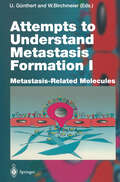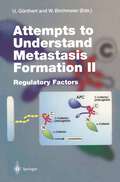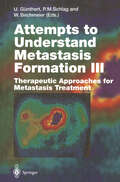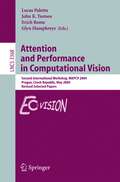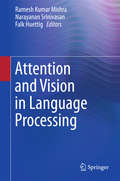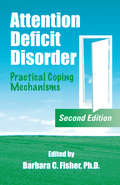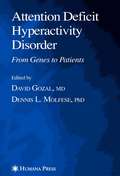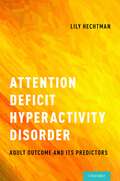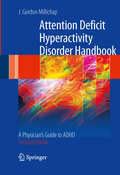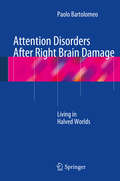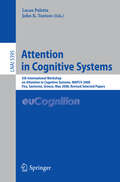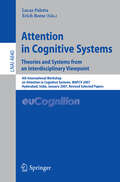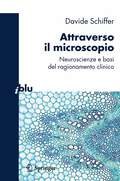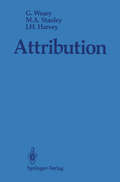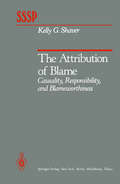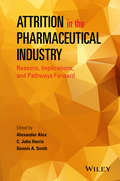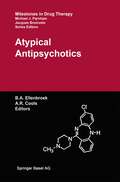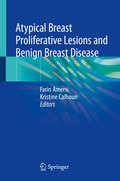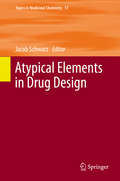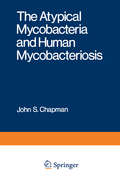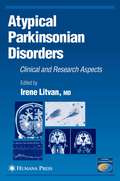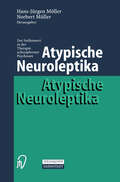- Table View
- List View
Attempts to Understand Metastasis Formation I: Metastasis-Related Molecules (Current Topics in Microbiology and Immunology #213/1)
by Ursula Günthert Walter BirchmeierIn metastasis, tumor cells disseminate from the primary lesion and home to secondary organs where they may remain dormant for a long time. Metastasis formation is still the most feared manifestation for tumor patients and clinicians. Although improvements have been made concerning earlier detection and specific therapy, most of the cancer patients still die of distant metastases. The pu-rpose of these three volumes is to review the recent progress in molecular metas tasis research and to attempt to further understand the biol ogy of this multifocal process. With respect to present day molecular biology, the pioneers of metastasis research established the basic concepts of metasta sis formation in the 1970s and 1980s, namely, clonal selection of metastatic cells, heterogeneity of metastatic subpopulations, organ specificity of metastasis and the importance of angio genesis (Fidler, Kripke, Nicolson, Folkman and others). In the 1980s and 1990s, several of the molecules involved were identified and their network interactions elucidated. These three volumes of Current Topics in Microbiology and Immuno logy compile the most recent developments on these meta stasis-related molecules; their interactions, regulation, and ways to interfere with their action. It became evident that metastasis-related molecules are confined to distinct cellular compartments, such as the extracellular space, the cell membrane, the cytoplasmic signalling network, and the nuclear regulatory system. For the complex metastatic cascade, proteolysis and alterations in adhesive functions are the most obvious and thus one of the most thoroughly investigated processes.
Attempts to Understand Metastasis Formation II: Regulatory Factors (Current Topics in Microbiology and Immunology #213/2)
by Ursula Günthert Walter BirchmeierAttempts to Understand Metastasis Formation III: Therapeutic Approaches for Metastasis Treatment (Current Topics in Microbiology and Immunology #213/3)
by Ursula Günthert Peter M. Schlag Walter BirchmeierIn metastasis, tumor cells disseminate from the primary lesion and home to secondary organs where they may remain dormant for a long time. Metastasis formation is still the most feared manifestation for tumor patients and clinicians. Although improvements have been made concerning earlier detection and specific therapy, most of the cancer patients still die of distant metastases. The purpose of these three volumes is to review the recent progress in molecular metas tasis research and to attempt to further understand the biol ogy of this multifocal process. With respect to present day molecular biology, the pioneers of metastasis research established the basic concepts of metasta sis formation in the 1970s and 1980s, namely, clonal selection of metastatic cells, heterogeneity of metastatic subpopulations, organ specificity of metastasis and the importance of angio genesis (Fidler, Kripke, Nicolson, Folkman and others). In the 1980s and 1990s, several of the molecules involved were identified and their network interactions elucidated. These three volumes of Current Topics in Microbiology and Immuno logy compile the most recent developments on these meta stasis-related molecules; their interactions, regulation, and ways to interfere with their action. It became evident that metastasis-related molecules are confined to distinct cellular compartments, such as the extracellular space, the cell membrane, the cytoplasmic signalling network, and the nuclear regulatory system. For the complex metastatic cascade, proteolysis and alterations in adhesive functions are the most obvious and thus one of the most thoroughly investigated processes.
Attention and Performance in Computational Vision: Second International Workshop, WAPCV 2004, Prague, Czech Republic, May 15, 2004, Revised Selected Papers (Lecture Notes in Computer Science #3368)
by Lucas Paletta John K. Tsotsos Erich Rome Glyn HumphreysInrecentresearchoncomputervisionsystems,attentionhasbeenplayingacrucialrolein mediatingbottom-upandtop-downpathsofinformationprocessing. Inappliedresearch, the development of enabling technologies such as miniaturized mobile sensors, video surveillance systems, and ambient intelligence systems involves the real-time analysis of enormous quantities of data. Knowledge has to be applied about what needs to be attendedto,andwhen,andwhattodoinameaningfulsequence,incorrespondencewith visual feedback. Methods on attention and control are mandatory to render computer vision systems more robust. The 2nd International Workshop on Attention and Performance in Computational Vision (WAPCV 2004) was held in the Czech Technical University of Prague, Czech Republic, as an associated workshop of the 8th European Conference on Computer - sion (ECCV 2004). The goal of this workshop was to provide an interdisciplinary forum tocommunicatecomputationalmodelsofvisualattentionfromvariousviewpoints,such as from computer vision, psychology, robotics and neuroscience. The motivation for - terdisciplinarity was communication and inspiration beyond the individual community, to focus discussion on computational modelling, to outline relevant objectives for p- formance comparison, to explore promising application domains, and to discuss these with reference to all related aspects of cognitive vision. The workshop was held as a single-day, single-track event, consisting of high-quality podium and poster presen- tions. Invited talks were given by John K. Tsotsos about attention and feature binding in biologically motivated computer vision and by Gustavo Deco about the context of attention, memory and reward from the perspective of computational neuroscience. The interdisciplinary program committee was composed of 21 internationally r- ognized researchers.
Attention and Vision in Language Processing
by Ramesh Kumar Mishra Narayanan Srinivasan Falk HuettigThis volume provides a comprehensive overview of the nature of attentional and visual processes involved in language comprehension. Key concerns include how linguistic and non-linguistic processes jointly determine language comprehension and production and how the linguistic system interfaces with perceptual systems and attention. Language scientists have traditionally considered language in isolation from other cognitive and perceptual systems such as attention, vision and memory. In recent years, however, it has become increasingly clear that language comprehension must be studied within interaction contexts. The study of multimodal interactions and attentional processes during language processing has thus become an important theoretical focus that guides many research programs in psycholinguistics and related fields.
Attention Deficit Disorder: Practical Coping Mechanisms
by Lisa V. BlitzCompletely revised and updated, this Second Edition spans every issue related to ADD care and treatment. New chapters focus on emerging issues, the overlap of sleep disorders, how sleep disorders mimic ADD/ADHD and/or increase the symptoms, ADHD and sleep apnea, ADHD and restless legs or periodic limb movements in sleep, sleep in children, adolesce
Attention Deficit Hyperactivity Disorder: From Genes to Patients (Contemporary Clinical Neuroscience)
by David Gozal Dennis L. MolfeseAttention deficit hyperactivity disorder (ADHD) is a common neurobehavioral disorder affecting 5–10% of children and adolescents and 3% of adults. Attention Deficit Hyperactivity Disorder: From Genes to Patients aims to provide a comp- hensive, state-of-the-art overview of the critical aspects of ADHD, and hopefully will serve as a quick and up-to-date reference source for professionals with an int- est in ADHD. The book is divided into three major areas that follow an historical survey. The first group of chapters deals with current theories on the pathophysiology of ADHD, and focuses on neurotransmitters and the contributions and validity of animal m- els. The second section emphasizes the evaluation and treatment of patients with ADHD, from the day-to-day approach by the clinical psychologist to the more sophisticated anatomical and functional imaging strategies that have emerged in the last decade. In addition, chapters dealing with specific impairments, such as those pertaining to reading, social interaction, and working memory, are also included for more detailed analysis of these important aspects and their respective contributions to global functioning. The third and final section provides an expanded review on the pharmacotherapy of ADHD and the appropriate methods for selection of specific drugs for individual patients based on drug kinetics and gene expression. David Gozal, MD Dennis L. Molfese, PhD vii CONTENTS Dedication . . . . . . . . . . . . . . . . . . . . . . . . . . . . . . . . . . . . . . . . . . . . . . . . . . . . . . . . . . . . . . . . . . . . . . . . . . . . . . . . . . . . . . . . . . . . . . . . . . . . . . . . . . . . . . . . . . . . . . . . . . . . . . . . . . . . . . . . . . . v Preface. . . . . . . . . . . . . . . . . . . . . . . . . . . . . . . . . . . . . . . . . . . . . . . . . . . . . . . . . . . . . . . . . . . . . . . . . . . . . . . . . . . . . . . . . . . . . . . . . . . . . . . . . . . . . . . . . . . . . . . . . . . . . . . . . . . . . . . . . . . . . . . vii Contributors. . . . . . . . . . . . . . . . . . . . . . . . . . . . . . . . . . . . . . . . . . . . . . . . . . . . . . . . . . . . . . . . . . . . . . . . . . . . . . . . . . . . . . . . . . . . . . . . . . . . . . . . . . . . . . . . . . . . . . . . . . . . . . . . . . . . . . . xi 1 Historical Aspects of Attention Deficit Hyperactivity Disorder . . . . . . . . . . . . . . . . . . . . . . . . . . . . . . . . . . . 1 Roscoe A. Dykman 2 Scanning the Genome for Attention Deficit Hyperactivity Disorder . . . . . . . . . . . . . . . . . . . . . . . . .
Attention Deficit Hyperactivity Disorder: Adult Outcome and Its Predictors
by Lily Hechtman, Md, Frcp, AbpnThe book provides a comprehensive summary of the best known and most highly respected well-controlled long-term prospective follow-up studies in ADHD. These studies followed children with ADHD and matched controls into young adulthood (mean age 20-25 years) and middle-age (mean age 41 years). They explore a wide variety of outcome areas, e.g. education, occupation, emotional and psychiatric functioning, substance use and abuse, sexual behavior, as well as legal problems. One chapter focuses particularly on the outcome of girls with ADHD. Outcome areas explored are thus comprehensive and clinically very relevant. The book also explores the possible predictors of adult outcome. A whole chapter is devoted to treatment (medication and psychosocial) as a predictor of outcome. In addition to treatment, predictors explored include characteristics of the child (e.g., IQ, severity of initial ADHD symptoms, initial comorbidity characteristics of the family, e.g., socioeconomic status, single parenthood, parental pathology, and family functioning. In a summary chapter, the impact and importance of these various predictors in different outcome areas, e.g. education, occupation, emotional/social functioning, antisocial behavior, substance use and abuse and risky sexual and driving behaviors are explored. In summary, the book provides a comprehensive view of the prognosis, e.g., long-term outcome of ADHD and key factors which can influence this outcome. Professionals and the general public will thus get a clear view of what can happen to children with ADHD as they proceed through adolescence and adulthood and address important prognostic and predictive factors in their treatment approaches to ensure better long-term outcome in patients with ADHD.
Attention Deficit Hyperactivity Disorder: Adult Outcome and Its Predictors
The book provides a comprehensive summary of the best known and most highly respected well-controlled long-term prospective follow-up studies in ADHD. These studies followed children with ADHD and matched controls into young adulthood (mean age 20-25 years) and middle-age (mean age 41 years). They explore a wide variety of outcome areas, e.g. education, occupation, emotional and psychiatric functioning, substance use and abuse, sexual behavior, as well as legal problems. One chapter focuses particularly on the outcome of girls with ADHD. Outcome areas explored are thus comprehensive and clinically very relevant. The book also explores the possible predictors of adult outcome. A whole chapter is devoted to treatment (medication and psychosocial) as a predictor of outcome. In addition to treatment, predictors explored include characteristics of the child (e.g., IQ, severity of initial ADHD symptoms, initial comorbidity characteristics of the family, e.g., socioeconomic status, single parenthood, parental pathology, and family functioning. In a summary chapter, the impact and importance of these various predictors in different outcome areas, e.g. education, occupation, emotional/social functioning, antisocial behavior, substance use and abuse and risky sexual and driving behaviors are explored. In summary, the book provides a comprehensive view of the prognosis, e.g., long-term outcome of ADHD and key factors which can influence this outcome. Professionals and the general public will thus get a clear view of what can happen to children with ADHD as they proceed through adolescence and adulthood and address important prognostic and predictive factors in their treatment approaches to ensure better long-term outcome in patients with ADHD.
Attention Deficit Hyperactivity Disorder Handbook: A Physician's Guide to ADHD
by J. Gordon MillichapAn expanded, updated, and revised edition, the ADHD Handbook, second edition covers recent advances in causes and management of ADHD, and includes more than 400 scientific references to peer-reviewed articles. It provides answers to the numerous questions that surround ADHD, including how is it diagnosed? What causes ADHD? What are the risks of associated learning and behavior disorders, tics, seizures, and headaches? What treatments are available? What are the choices of medications and the risks of side effects? How can adverse effects be avoided? What are the alternatives to medication? Do children outgrow ADHD, and how long is treatment required? ADHD Handbook is written for neurologists, pediatricians, practicing physicians, residents, fellows and students of medicine, psychologists, educators, occupational and speech therapists, nurse practitioners and other healthcare providers. It also offers parents a readable, but uniquely well documented and objective account of ADHD symptoms, diagnosis, medications, alternative treatments, and management.
Attention Disorders After Right Brain Damage: Living in Halved Worlds
by Paolo BartolomeoThis book provides an overview of attentional impairments in brain-damaged patients from both clinical and neuroscientific perspectives, and aims to offer a comprehensive, succinct treatment of these topics useful to both clinicians and scholars. A main focus of the book concerns left visual neglect, a dramatic but often overlooked consequence of right hemisphere damage, usually of vascular origin, but also resulting from other causes such as neurodegenerative conditions. The study of neglect offers a key to understand the brain’s functioning at the level of large-scale networks, and not only based on discrete anatomical structures. Patients are often unaware of their deficits (anosognosia), and often obstinately deny being hemiplegic. Diagnosis is important because neglect predicts poor functional outcome in stroke. Moreover, effective rehabilitation strategies are available, and there are promising possibilities for pharmacological treatments.Attention Disorders After Right Brain Damage is aimed at clinical neurologists, medics in physical medicine and rehabilitation, clinical psychologists and neuropsychologists. It will also be useful for graduate students and medical students who wish to understand the topic of attention systems and improve their knowledge of the neurocognitive mechanisms of attentional deficits. In addition, clinical researchers in neuropsychology and cognitive neuroscience will find in this book an up to date overview of current research dealing with the attention systems of the human brain.
Attention in Cognitive Systems: International Workshop on Attention in Cognitive Systems, WAPCV 2008 Fira, Santorini, Greece, May 12, 2008, Revised Selected Papers (Lecture Notes in Computer Science #5395)
by Lucas Paletta John K. TsotsosAttention has represented a core scienti?c topic in the design of AI-enabled systems in the last few decades. Today, in the ongoing debate, design, and c- putationalmodelingofarti?cialcognitivesystems,attentionhasgainedacentral position as a focus of research. For instance, attentional methods are considered in investigating the interfacing of sensory and cognitive information processing, for the organization of behaviors, and for the understanding of individual and social cognition in infant development. Whilevisualcognitionplaysacentralroleinhumanperception,?ndingsfrom neuroscience and experimental psychology have provided strong evidence about the perception–action nature of cognition. The embodied nature of senso- motor intelligence requires a continuous and focused interplay between the c- trolofmotoractivitiesandtheinterpretationoffeedbackfromperceptualmod- ities. Decision making about the selection of information from the incoming sensory stream – in tune with contextual processing on a current task and an agent’s global objectives – becomes a further challenging issue in attentional control. Attention must operate at interfaces between a bottom-up-driven world interpretationandtop-down-driveninformationselection,thusactingatthecore of arti?cial cognitive systems. These insights have already induced changes in AI-related disciplines, such as the design of behavior-based robot control and the computational modeling of animats. Today, the development of enabling technologiessuch as autonomous robotic systems,miniaturizedmobile–evenwearable–sensors,andambientintelligence systems involves the real-time analysis of enormous quantities of data. These data have to be processed in an intelligent way to provide “on time delivery” of the required relevant information. Knowledge has to be applied about what needs to be attended to, and when, and what to do in a meaningful sequence, in correspondence with visual feedback.
Attention in Cognitive Systems. Theories and Systems from an Interdisciplinary Viewpoint: 4th International Workshop on Attention in Cognitive Systems, WAPCV 2007 Hyderabad, India, January 8, 2007 Revised Selected Papers (Lecture Notes in Computer Science #4840)
by Lucas Paletta Erich RomeThis volume provides a much-needed interdisciplinary angle on the subject of attention in cognitive systems. It constitutes the thoroughly refereed post-workshop proceedings of the 5th International Workshop on Attention in Cognitive Systems, held in Hyderabad, India, in January 2007. The 31 papers are organized in topical sections that cover every aspect of the subject, from the embodiment of attention and its cognitive control, to the applications of attentive vision.
Attraverso il microscopio: Neuroscienze e basi del ragionamento clinico (I blu)
by Davide SchifferIl libro prende le mosse dai pensieri di un giovane che alla maturità liceale si trova affascinato dalla cultura dei classici greco-latini, dai rudimenti filosofici e dall’impatto con le scienze fisiche e naturali. Il latino e i suoi naturalisti hanno suscitato un fervore verso la Botanica Sistematica che lo riporta a Linneo e quindi alla conoscenza del mondo naturale, all’esperienza della denominazione dell’esistente come conoscenza e quindi agli universali di Guglielmo d’Occam. La scelta della facoltà di Medicina fungerà da mediazione fra la filosofia, vista come via alla verità, e la biologia con il grande mistero dell’uomo nella sua dualità di mente/corpo. L’incontro con il microscopio aprirà la strada all’approfondimento della biologia, ma anche alla ricerca dei significati e delle interpretazioni del mondo. I meccanismi della percezione, visiva in particolare, nelle articolazioni della Gestaltpsychologie, e i suoi rapporti con il mondo interiore, sia quello della memoria esplicita che della memoria implicita, sono affrontati nell’esplorazione del mondo attraverso il microscopico e nella ricerca di una obiettività scientifica. Locke e Kant, Popper e Heidegger fanno da contraltare a Ramon y Cajal, Golgi, Kandel, Heisenberg, mentre la semiotica illumina e confonde sull’importanza del linguaggio per la conoscenza. Il segno e il suo riconoscimento si trasferiscono nella scienza attraverso l’inter-soggettività e il linguaggio appare come l’unico modo di penetrare l’esistente. Il libro si dilunga sull’origine di certe denominazioni in patologia tratte dalla vita quotidiana, sull’antropomorfismo spesso applicato agli oggetti del campo microscopico, sempre illustrati su base fenomenologica e psicologica.
Attribution
by Gifford Weary Melinda A. Stanley John H. HarveyThis book initially was conceived in 1986 by Weary and Harvey as a revi sion and update of their 1981 Perspectives on Attributional Processes (pub lished by Wm. C. Brown," Dubuque, Iowa). However: toe extensive nature of recent work on attributional processes and the opportunity to collabo rate with Melinda Stanley as a coauthor led to a plan to develop a more comprehensive work than the 1981 book. It definitely is an amalgam of our interests in social and clinical psychology. It represents our commitment to basic theoretical and empirical inquiry blended with the applications of ideas and methods to understanding attribution in more naturalistic set tings, and as it unfolds in the lives of different kinds of people coping with diverse problems of living. The book represents a commitment also to the breadth of approach to attribution questions epitomized by Fritz Heider's uniquely creative mind and work in pioneering the area. To us, the attribu tional approach is not a sacrosanct school of thought on the human condi tion. It is, rather, a body of ideas and findings that we find to be highly useful in our work as social (JH and GW) and clinical (GW and MS) psychology scholars. It is an inviting approach that, as we shall describe in the book, brings together ideas and work from different fields in psychology-all concerned with the pervasive and inestimab1e importance of interpretive activity in human experience and behavior.
The Attribution of Blame: Causality, Responsibility, and Blameworthiness (Springer Series in Social Psychology)
by K.G. ShaverHow can we identify the causes of events? What does it mean to assert that someone is responsible for a moral affront? Under what circumstances should we blame others for wrongdoing? The related, but conceptually distinct, issues of causality, responsibility, and blameworthiness that are the subject of this book play a critical role in our everyday social encounters. As very young children we learn to assert that "it wasn't my fault," or that "I didn't mean to do it." Responsibility and blame follow us into adulthood, as personal or organizational failings require explanation. Although judgments of moral accountability are quickly made and adamantly defended, the process leading to those judgments is not as simple as it might seem. Psychological research on causality and responsibility has not taken complete advantage of a long tradition of philosophical analysis of these concepts. Philosophical discussions, for their part, have not been sufficiently I1ware of the psychological realities. An assignment of blame is a social explanation. It is the outcome of a process that begins with an event having negative consequences, involves judgments about causality, personal responsibility, and possible mitigation. The result can be an assertion, or a denial, of individual blameworthiness. The purpose of this book is to develop a comprehensive theory of how people assign blame.
Attrition in the Pharmaceutical Industry: Reasons, Implications, and Pathways Forward
by Alexander Alex C. John Harris Dennis A. SmithWith a focus on case studies of R&D programs in a variety of disease areas, the book highlights fundamental productivity issues the pharmaceutical industry has been facing and explores potential ways of improving research effectiveness and efficiency. • Takes a comprehensive and holistic approach to the problems and potential solutions to drug compound attrition• Tackles a problem that adds billions of dollars to drug development programs and health care costs• Guides discovery and development scientists through R&D stages, teaching requirements and reasons why drugs can fail• Discusses potential ways forward utilizing new approaches and opportunities to reduce attrition
Attrition in the Pharmaceutical Industry: Reasons, Implications, and Pathways Forward
by Alexander Alex C. John Harris Dennis A. SmithWith a focus on case studies of R&D programs in a variety of disease areas, the book highlights fundamental productivity issues the pharmaceutical industry has been facing and explores potential ways of improving research effectiveness and efficiency. • Takes a comprehensive and holistic approach to the problems and potential solutions to drug compound attrition• Tackles a problem that adds billions of dollars to drug development programs and health care costs• Guides discovery and development scientists through R&D stages, teaching requirements and reasons why drugs can fail• Discusses potential ways forward utilizing new approaches and opportunities to reduce attrition
Atypical Antipsychotics (Milestones in Drug Therapy)
by Bart A. Ellenbroek Alexander R. CoolsThe introduction of chlorpromazine in 1953, and haloperidol in 1958, into clinical practice dramatically altered the therapy of schizophrenic patients. Although representing by no means a cure for this severe psychiatric ill ness, it allowed, for the first time, to adequately control the severe hallu cinations and delusional beliefs which prevent these patients from leading a more or less independent life. Indeed these antipsychotics (and the many congeners that were to follow) significantly reduced the number ofchronic schizophrenic inpatients in psychiatric clinics all over the world. However soon after their introduction it became clear that, like all other available drugs, antipsychotics were by no means miracle drugs. In fact, two major problems appeared. First, the antipsychotics had very little effect on the so-called negative or defect symptoms, like social isolation, apathy and anhedonia, and secondly virtually all antipsychotics produced a number of side-effects, of which the neurological (often called extra pyramidal) side-effects were the most troublesome. Especially the tardive dyskinesia, which occurred in about 15 to 20% of the patients after pro longed treatment, represented a major problem in the treatment of schizo phrenic patients.
Atypical Breast Proliferative Lesions and Benign Breast Disease
by Farin Amersi Kristine CalhounManagement of atypical breast lesions continues to evolve. There is considerable controversy as to whether these entities represent risk factors for future breast cancer or whether they are instead precursor lesions. A better understanding of the prognostic and therapeutic implications of each of these lesions is important for assessing subsequent breast cancer risk. Risk assessment tools are available for screening high risk patients and understanding the utility and limitations of these tools is important for all clinicians involved in the care of patients. There have been significant advances in breast cancer screening in the last several year including breast tomosynthesis, automated breast ultrasound, molecular imaging, as well as accelerated breast MRI protocols. This has raised the question: Do women at risk for breast cancer need additional breast cancer screening using these newer imaging modalities? In addition, with these advances in imaging, can women with atypical proliferative lesions be observed rather than undergoing surgical excision as some suggest? The role of observation, surgical excision and even prophylactic mastectomy in women with atypical proliferative lesions continues to be debated; however there is data that can guide physicians in the management of these patients. Pleomorphic Lobular carcinoma in-situ (PLCIS) is a distinct pathological entity within LCIS and there is no consensus regarding surgical margins or the need for adjuvant treatment to prevent recurrence. Recently, ductal carcinoma in-situ (DCIS) has been the subject of much controversy: is it truly a cancer or is it instead a precursor lesion. The traditional management of DCIS with lumpectomy and radiation is now being debated and recent data demonstrates that low grade DCIS can be managed with observation. Clinical trials are now accruing patients with low and intermediate grade DCIS to observation and close surveillance, and not surgical excision. Finally, new guidelines for chemoprevention with the use of tamoxifen and raloxifen for women with atypical proliferative lesions, LCIS, PLCIS, and DCIS are available and should be discussed as an option when guiding management of these patients. This book will provide a comprehensive review of this field and will serve as a valuable resource for clinicians, general surgeons, breast surgeons and surgical oncologists, as well as researchers with an interest in the management of atypical breast lesions. The book will review new data about breast cancer, risk factors for breast cancer, pathological features unique to each entity, the characteristic findings on imaging, risk stratification for genetic testing, as well as the current evidence-based management of each of these breast lesions. Our text will provide assessment tools for risk prediction of breast cancer. We will provide data on the current imaging modalities, as well as advanced screening options available for diagnosis and following these patients. Current management of many of these lesions continues to be controversial in regard to observation with close surveillance versus the need for surgical excision of these lesions based on future risk or whether these lesions are precursor lesion. For ductal carcinoma in-situ, the debate continues in regards to whether this disease entity is a precursor lesion that can be managed with observation or hormonal therapy, or is DCIS cancer and treated with lumpectomy and radiation. Several studies have been published where patients are managed with observation and treatment with hormonal therapy before surgical management. New trials have already begun accruing patients with low to intermediate grade DCIS where patients will be managed with observation versus hormonal therapy only. Management of DCIS continues to evolve and current management will be discussed This text will provide a concise but comprehensive summary of the current management of patients with atypical breast proliferative lesions and some benign breast lesions and will help guided management of these
Atypical Elements in Drug Design (Topics in Medicinal Chemistry #17)
by Jacob SchwarzMedicinal chemistry is both science and art. The science of medicinal chemistry offers mankind one of its best hopes for improving the quality of life. The art of medicinal chemistry continues to challenge its practitioners with the need for both intuition and experience to discover new drugs. Hence sharing the experience of drug research is uniquely beneficial to the field of medicinal chemistry. Drug research requires interdisciplinary team-work at the interface between chemistry, biology and medicine. Therefore, the topic-related series Topics in Medicinal Chemistry covers all relevant aspects of drug research, e.g. pathobiochemistry of diseases, identification and validation of (emerging) drug targets, structural biology, drugability of targets, drug design approaches, chemogenomics, synthetic chemistry including combinatorial methods, bioorganic chemistry, natural compounds, high-throughput screening, pharmacological in vitro and in vivo investigations, drug-receptor interactions on the molecular level, structure-activity relationships, drug absorption, distribution, metabolism, elimination, toxicology and pharmacogenomics. In general, special volumes are edited by well known guest editors.
The Atypical Mycobacteria and Human Mycobacteriosis (Current Topics in Infectious Disease)
by John ChapmanNearly twenty years ago a symposium convened at Dallas, Texas, to con sider the place of atypical mycobacteria among agents of human disease. An edited and condensed version of that symposium was subsequently published and since that time has constituted the only bound source of infor mation covering broad aspects of mycobacterial disease. In the years since a vast amount of information has accumulated in periodical literature, some of which is not readily accessible. The time seems suitable for a comprehensive collection of this scattered material into a single book. The aim has not been to produce an exhaustive account of mycobacteria and mycobacterioses, but rather to concentrate on salient points and particularly on those most generally useful to a diverse group of interests: mycobacteriology, pathology, epidemiology, and, of course, clinical fields. In Appendix A there appear in summary form manifestations of myco bacteria as they have occurred among clinical specialities, such as ortho pedic surgery, dermatology, and urology. These summaries are designed to serve as guides to more probable infections and to lead to more extensive reading with respect to the specific organism encountered. Appendix C presents, also in summary form, drugs, regimens, duration of treatment, and toxicities to permit ready reference to less familiar anti microbial agents. These are suggestive only, useful when the general nature of the organism is known but not the specific susceptibility of the individual strain.
Atypical Parkinsonian Disorders: Clinical and Research Aspects (Current Clinical Neurology)
by Irene LitvanA comprehensive review of what is known not only about the cause and treatment of atypical parksonian disorders, but also the issues that clinicians, researchers, patients, and caregivers face in dealing with them. The authors cover the basic science (history, epidemiology, genetics, pathology, nosology, computer modeling, and animal models), detailed clinical and laboratory assessments, and available diagnostic tools, including neuropsychiatric, neurologic, neuropsychologic, speech, electrophysiologic, and imaging evaluations. Current and future therapeutic approaches are also detailed, along with extensive discussions about future research directions.
